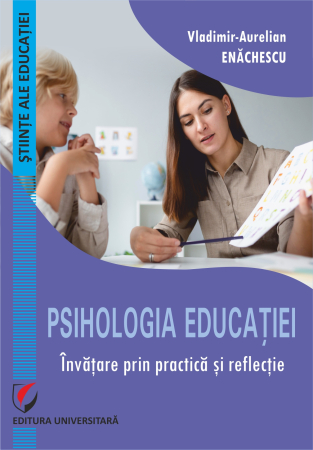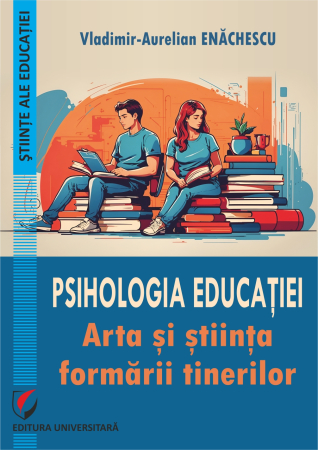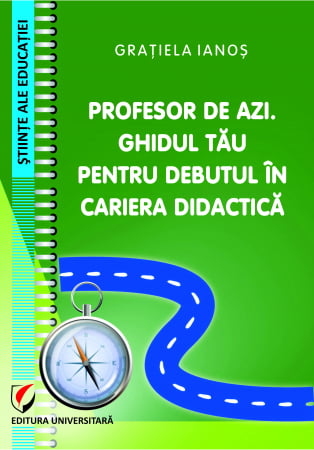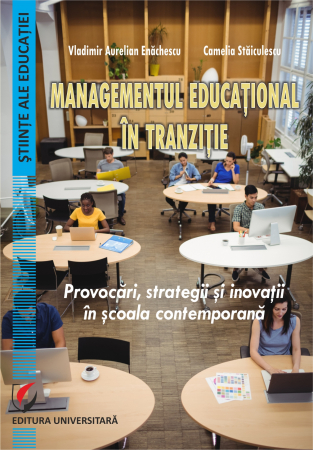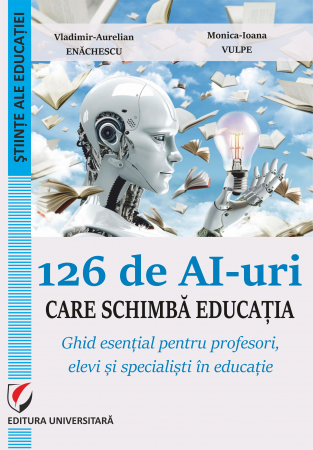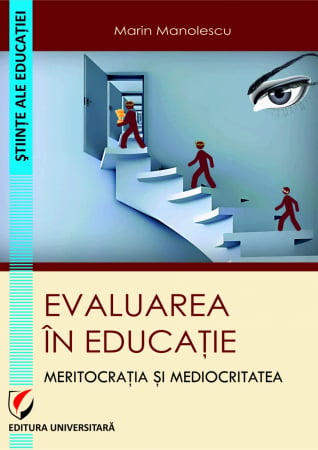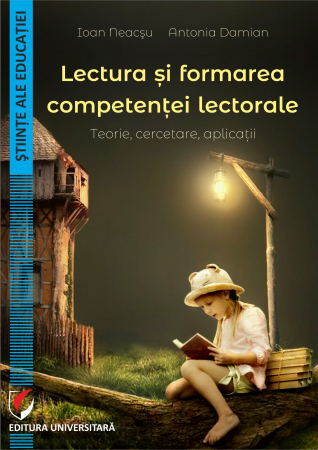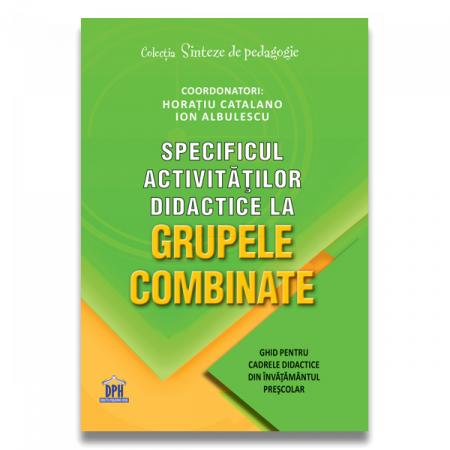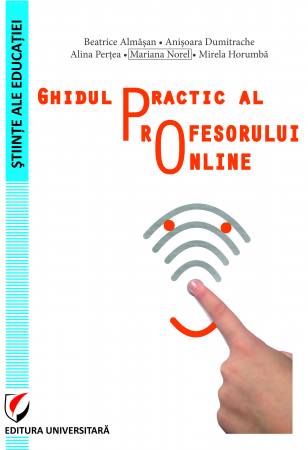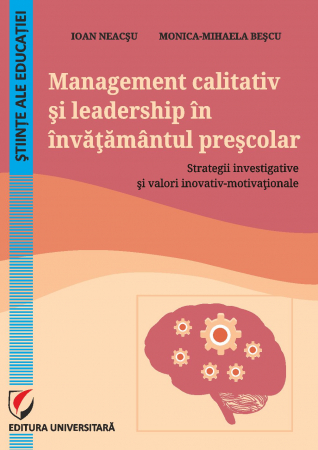Manuscript proposals: [email protected] / 0745 204 115 //// Tracking orders Individuals / Sales: 0745 200 357 / Orders Legal entities: 0721 722 783
Publisher: Editura Universitară
Author: Mona Badoi-Hammami
Edition: I
Pages: 198
Publisher year: 2023
ISBN: 978-606-28-1584-4
DOI: https://doi.org/10.5682/9786062815844
Product Code:
9786062815844
Do you need help?
0745 200 357
- Description
- Download (1)
- Authors
- Content
- More details
- Reviews (0)
In order for a person to exercise the profession of teaching, he must go through a period of preparation that will continue even during his learning in the professional field. But neither the experience, the general culture, the amount of information at his disposal or his academic training, are not enough if he does not have an innate ability to communicate information, an ability necessary for learning, provided it is integrated with the appropriate professional training. In conclusion, it is necessary for a person who wants to enter the field of education to know the terms of pedagogy, their origin, uses and working mechanism.
In this book, the pedagogical terms, their functions, their use and their origins will also be presented, so that the mechanism of the basic triad in this field of indoctrination or teaching, learning and evaluation can be understood, in a way that facilitates the achievement of the objectives educational effectively in accordance with recent changes.
Therefore, this book was divided into the following chapters:
The first chapter is dedicated to explaining the theoretical contributions of pedagogy;
In the second chapter, the psychopedagogy of communication or didactic communication is presented;
In the third chapter, the aims of education are presented;
In the fourth chapter, learning is described from the perspective of education and didactics;
In the fifth chapter, teaching and learning theories are presented.
This order will allow you to understand the requirements of the profession, the goals of education and the easiest ways to achieve them.
By identifying the pedagogical inputs, the understanding of the theories in this field will be facilitated and links will be created between them in order to build an efficient work strategy within the class, ensuring the teacher achieves the main goal: that as many students as possible acquire competences and honorable achievements, satisfying their individual needs and orientations, of course, proportional to society's requirements.
In this book, the pedagogical terms, their functions, their use and their origins will also be presented, so that the mechanism of the basic triad in this field of indoctrination or teaching, learning and evaluation can be understood, in a way that facilitates the achievement of the objectives educational effectively in accordance with recent changes.
Therefore, this book was divided into the following chapters:
The first chapter is dedicated to explaining the theoretical contributions of pedagogy;
In the second chapter, the psychopedagogy of communication or didactic communication is presented;
In the third chapter, the aims of education are presented;
In the fourth chapter, learning is described from the perspective of education and didactics;
In the fifth chapter, teaching and learning theories are presented.
This order will allow you to understand the requirements of the profession, the goals of education and the easiest ways to achieve them.
By identifying the pedagogical inputs, the understanding of the theories in this field will be facilitated and links will be created between them in order to build an efficient work strategy within the class, ensuring the teacher achieves the main goal: that as many students as possible acquire competences and honorable achievements, satisfying their individual needs and orientations, of course, proportional to society's requirements.
-
Training in learning and in the development of the didactic process
Download
MONA BADOI-HAMMAMI
INTRODUCTION / 9
CHAPTER I: INTRODUCTION TO PEDAGOGY AND THE SCIENCES OF EDUCATION / 11
Educational terms and expressions / 11
1. Education / 11
1.1. The importance and functions of education / 13
1.2. Forms of education / 14
1.3. The main purposes of education / 22
1.4. Self-education / 23
2. Education sciences / 25
2.1. "Science of education" or "Science of education" / 27
2.2. The functions of education sciences / 27
2.3. The components of education sciences / 28
3. Pedagogy / 28
3.1. The evolution of the concept of education until it reached pedagogy / 28
3.2. Definition of the term pedagogy / 31
3.3. Types of pedagogy / 33
3.4. The main branches of pedagogy / 38
3.5. Postmodern pedagogy / 40
3.6. The characteristics of postmodern pedagogy / 41
3.7. Technological methods and simulations in the training of students according to postmodern pedagogy / 42
4. The educational process / 44
4.1. The structure of the educational process / 46
4.2. Models of the educational process / 47
4.3. The general characteristics of the educational process / 49
4.4. The dimensions of the educational process / 50
4.5. The educational process and its aspects / 52
4.6. The components of the educational process / 52
5. Didactics / 54
5.1. Types of teaching / 57
5.2. Justifications for the adoption of the didactic concept / 58
5.3. Didactics a comprehensive and integrated system / 60
5.4. Didactic activity / 61
5.5. The relationship between teaching and professional educational training / 61
5.6. Didactic components / 63
5.7. Factors affecting teaching / 68
5.8. The didactic triangle / 70
5.9. Teaching contract / 74
6. Teaching staff / 77
6.1. The necessary didactic skills, in fulfilling the various didactic tasks of the teacher in the training process / 78
6.2. Teachers' educational perceptions / 82
6.3. The essential competencies of the successful teacher / 85
Chapter II: Psychopedagogy of communication or didactic communication / 92
1. Effective communication techniques and means / 94
2. The main functions of communication / 95
3. Scheme of the communication process / 96
4. Forms of communication in the class of students / 97
5. Nonverbal communication / 99
5.1. The functions of nonverbal communication / 99
5.2. Types of non-verbal communication in the class of students / 100
6. Paraverbal communication / 101
6.1. Components of paraverbal language / 102
7. Communication and social influence / 103
CHAPTER III: THE PURPOSES OF EDUCATION / 104
1. Sources from which the finalities come / 104
2. Classification of educational purposes / 105
2.1. Long-term educational goals / 106
2.2. Short-term methodological goals, educational objectives / 108
3. Content objectives - operational objectives / 112
3.1. Behavioral/operational objectives and their importance / 113
3.2. Standards, criteria for the formulation of operational/behavioral objectives / 115
3.3. Classification of operational/behavioral objectives / 116
3.4. Correct formulation of operational objectives / 144
4. Educational skills / 146
4.1. The difference between objectives and competences / 147
CHAPTER IV: CORRELATION BETWEEN EDUCATION, DIDACTIC AND LEARNING / 149
1. Education / 149
2. Didactics / 150
3. Learning / 150
3.1. Learning styles / 152
3.2. Learning from a psychological perspective / 154
3.3. Learning in general terms / 155
3.4. Characteristics of learning / 156
3.5. Learning conditions / 157
3.6. Comparative analysis between internal and external learning factors / 158
3.7. Types of learning / 160
3.8. Methods that the teacher can use to motivate students to learn / 161
3.9. Learning styles in students / 162
4. Mental maps and how to use them in the educational field / 165
4.1. Design stages of mental maps / 168
4.2. The thinking method for creating a mental map / 170
4.3. The benefits of mental maps / 171
CHAPTER V: TEACHING AND LEARNING THEORIES / 173
1. Theory and teaching model / 175
1.2. Characteristics of the teaching model: / 176
1.3. Teaching theories / 176
1.3.2. The theory of multiple intelligences / 178
1.3.3. Zone of close development (zpd) and skeleton steps / 179
2. Learning theories / 180
2.1. Theory of conditioned learning / 180
2.2. Associationist theory / 183
2.2.1. The learning theory of b.f. skinner / 184
2.3. Gestalt theory / 189
BIBLIOGRAPHY / 190
CHAPTER I: INTRODUCTION TO PEDAGOGY AND THE SCIENCES OF EDUCATION / 11
Educational terms and expressions / 11
1. Education / 11
1.1. The importance and functions of education / 13
1.2. Forms of education / 14
1.3. The main purposes of education / 22
1.4. Self-education / 23
2. Education sciences / 25
2.1. "Science of education" or "Science of education" / 27
2.2. The functions of education sciences / 27
2.3. The components of education sciences / 28
3. Pedagogy / 28
3.1. The evolution of the concept of education until it reached pedagogy / 28
3.2. Definition of the term pedagogy / 31
3.3. Types of pedagogy / 33
3.4. The main branches of pedagogy / 38
3.5. Postmodern pedagogy / 40
3.6. The characteristics of postmodern pedagogy / 41
3.7. Technological methods and simulations in the training of students according to postmodern pedagogy / 42
4. The educational process / 44
4.1. The structure of the educational process / 46
4.2. Models of the educational process / 47
4.3. The general characteristics of the educational process / 49
4.4. The dimensions of the educational process / 50
4.5. The educational process and its aspects / 52
4.6. The components of the educational process / 52
5. Didactics / 54
5.1. Types of teaching / 57
5.2. Justifications for the adoption of the didactic concept / 58
5.3. Didactics a comprehensive and integrated system / 60
5.4. Didactic activity / 61
5.5. The relationship between teaching and professional educational training / 61
5.6. Didactic components / 63
5.7. Factors affecting teaching / 68
5.8. The didactic triangle / 70
5.9. Teaching contract / 74
6. Teaching staff / 77
6.1. The necessary didactic skills, in fulfilling the various didactic tasks of the teacher in the training process / 78
6.2. Teachers' educational perceptions / 82
6.3. The essential competencies of the successful teacher / 85
Chapter II: Psychopedagogy of communication or didactic communication / 92
1. Effective communication techniques and means / 94
2. The main functions of communication / 95
3. Scheme of the communication process / 96
4. Forms of communication in the class of students / 97
5. Nonverbal communication / 99
5.1. The functions of nonverbal communication / 99
5.2. Types of non-verbal communication in the class of students / 100
6. Paraverbal communication / 101
6.1. Components of paraverbal language / 102
7. Communication and social influence / 103
CHAPTER III: THE PURPOSES OF EDUCATION / 104
1. Sources from which the finalities come / 104
2. Classification of educational purposes / 105
2.1. Long-term educational goals / 106
2.2. Short-term methodological goals, educational objectives / 108
3. Content objectives - operational objectives / 112
3.1. Behavioral/operational objectives and their importance / 113
3.2. Standards, criteria for the formulation of operational/behavioral objectives / 115
3.3. Classification of operational/behavioral objectives / 116
3.4. Correct formulation of operational objectives / 144
4. Educational skills / 146
4.1. The difference between objectives and competences / 147
CHAPTER IV: CORRELATION BETWEEN EDUCATION, DIDACTIC AND LEARNING / 149
1. Education / 149
2. Didactics / 150
3. Learning / 150
3.1. Learning styles / 152
3.2. Learning from a psychological perspective / 154
3.3. Learning in general terms / 155
3.4. Characteristics of learning / 156
3.5. Learning conditions / 157
3.6. Comparative analysis between internal and external learning factors / 158
3.7. Types of learning / 160
3.8. Methods that the teacher can use to motivate students to learn / 161
3.9. Learning styles in students / 162
4. Mental maps and how to use them in the educational field / 165
4.1. Design stages of mental maps / 168
4.2. The thinking method for creating a mental map / 170
4.3. The benefits of mental maps / 171
CHAPTER V: TEACHING AND LEARNING THEORIES / 173
1. Theory and teaching model / 175
1.2. Characteristics of the teaching model: / 176
1.3. Teaching theories / 176
1.3.2. The theory of multiple intelligences / 178
1.3.3. Zone of close development (zpd) and skeleton steps / 179
2. Learning theories / 180
2.1. Theory of conditioned learning / 180
2.2. Associationist theory / 183
2.2.1. The learning theory of b.f. skinner / 184
2.3. Gestalt theory / 189
BIBLIOGRAPHY / 190
In order for a person to exercise the profession of teaching, he must go through a period of preparation that will continue even during his learning in the professional field. But neither the experience, the general culture, the amount of information at his disposal or his academic training, are not enough if he does not have an innate ability to communicate information, an ability necessary for learning, provided it is integrated with the appropriate professional training. In conclusion, it is necessary for a person who wants to enter the field of education to know the terms of pedagogy, their origin, uses and working mechanism.
In this book, the pedagogical terms, their functions, their use and their origins will also be presented, so that the mechanism of the basic triad in this field of indoctrination or teaching, learning and evaluation can be understood, in a way that facilitates the achievement of the objectives educational effectively in accordance with recent changes.
Therefore, this book was divided into the following chapters:
The first chapter is dedicated to explaining the theoretical contributions of pedagogy;
In the second chapter, the psychopedagogy of communication or didactic communication is presented;
In the third chapter, the aims of education are presented;
In the fourth chapter, learning is described from the perspective of education and didactics;
In the fifth chapter, teaching and learning theories are presented.
This order will allow you to understand the requirements of the profession, the goals of education and the easiest ways to achieve them.
By identifying the pedagogical inputs, the understanding of the theories in this field will be facilitated and links will be created between them in order to build an efficient work strategy within the class, ensuring the teacher achieves the main goal: that as many students as possible acquire competences and honorable achievements, satisfying their individual needs and orientations, of course, proportional to society's requirements.
In this book, the pedagogical terms, their functions, their use and their origins will also be presented, so that the mechanism of the basic triad in this field of indoctrination or teaching, learning and evaluation can be understood, in a way that facilitates the achievement of the objectives educational effectively in accordance with recent changes.
Therefore, this book was divided into the following chapters:
The first chapter is dedicated to explaining the theoretical contributions of pedagogy;
In the second chapter, the psychopedagogy of communication or didactic communication is presented;
In the third chapter, the aims of education are presented;
In the fourth chapter, learning is described from the perspective of education and didactics;
In the fifth chapter, teaching and learning theories are presented.
This order will allow you to understand the requirements of the profession, the goals of education and the easiest ways to achieve them.
By identifying the pedagogical inputs, the understanding of the theories in this field will be facilitated and links will be created between them in order to build an efficient work strategy within the class, ensuring the teacher achieves the main goal: that as many students as possible acquire competences and honorable achievements, satisfying their individual needs and orientations, of course, proportional to society's requirements.
If you want to express your opinion about this product you can add a review.
write a review

6359.png)
![Training in learning and in the development of the didactic process - Mona Badoi-Hammami [1] Training in learning and in the development of the didactic process - Mona Badoi-Hammami [1]](https://gomagcdn.ro/domains/editurauniversitara.ro/files/product/large/instruirea-in-invatare-si-in-desfasurarea-procesului-didactic-250487.jpg)
